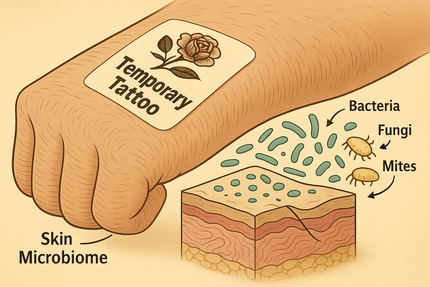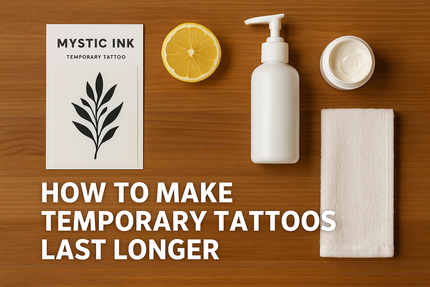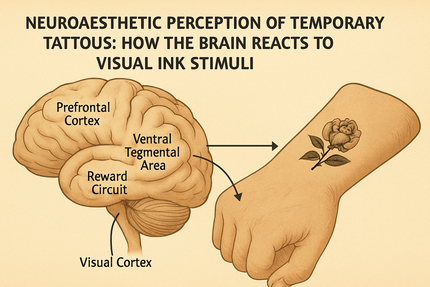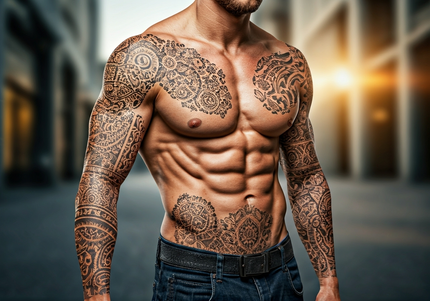Key Highlights
Diverse Aesthetic & Cultural Expression – From Polynesian tribal geometry to Japanese irezumi, contemporary arm tattoos accommodate a broad spectrum of personal narratives and sociocultural identities.
Documented Popularity – Roughly one‑third of U.S. adults (32%) now have at least one tattoo, reflecting a marked normalization of body art in mainstream society (Pew Research Center, 2023).
Pain Is Site‑Specific – Systematic reviews of sensory innervation confirm that bony, low‑adipose regions (e.g., wrist, elbow, inner biceps) elicit significantly higher nociceptive responses than well‑padded areas such as the deltoid (Healthline Pain Chart, 2024).
Evidence‑Based After‑Care – Dermatology guidelines emphasize gentle cleansing, fragrance‑free emollients, and disciplined UV avoidance to prevent infection, pigment loss, and hypertrophic scarring (Cleveland Clinic, 2024).
Long‑Term Photoprotection – Peer‑reviewed data link inadequate sun protection to premature fading and increased carcinogenic risk in tattooed skin; broad‑spectrum SPF ≥ 30 is strongly advised once re‑epithelialization is complete (Nguyen et al., 2020; AAD Statement, 2025).
Introduction
The adult male arm offers an anatomically accommodating canvas—ample surface area, clear musculature, and straightforward post‑procedural visibility. Whether the intent is discreet minimalism or a full chromatic sleeve, the arm enables artists to translate autobiographical, spiritual, or commemorative themes into a durable pigment narrative.
Popular Arm Tattoo Styles for Men
1. Tribal Arm Tattoos
Bold black patterns rooted in cultural traditions symbolize strength, heritage, and courage. Different tribal origins (e.g., Maori, Polynesian) convey unique stories. Skilled tattoo artists deliver crisp lines that maintain the cultural integrity of the designs.
2. Sleeve Tattoos
Full-arm sleeves allow for expansive, interconnected storytelling. These often require multiple sessions with artists who ensure cohesive style and theme, ranging from mythology to natural elements.
3. Minimalist Linework Designs
Sharp, clean, simple lines produce elegant tattoos that convey deep symbolism with understated style—ideal for first-timers.
4. Japanese Irezumi Tattoos
Featuring iconic imagery like dragons and koi fish, these bold, brightly colored tattoos represent strength, wisdom, and perseverance, employing intricate shading and vibrant color work.
5. Portrait Tattoos
Highly realistic tattoos capturing fine details of loved ones or idols require exceptional artistic skill to ensure lifelike accuracy and emotional resonance.
6. Geometric Patterns
Symmetrical shapes like triangles and circles appeal to those valuing order and balance, forming aesthetically clean yet meaningful compositions.
7. Animal and Wildlife Tattoos
Symbolizing traits like loyalty, strength, or freedom, animal tattoos vary from simple line drawings to vibrant, lifelike portrayals.
8. Skull Tattoos
Representing mortality, toughness, and rebellion, skull tattoos often incorporate additional motifs such as roses or clocks to deepen meaning.
9. Nautical-Themed Tattoos
Anchors, ships, and compasses reflect adventure, loyalty, and guidance, favored by those with a connection to the sea or exploration.
10. Religious Symbol Tattoos
Expressing faith and spirituality, symbols like crosses, om, or lotus flowers carry profound personal and cultural significance.
11. Abstract Art Tattoos
Nontraditional shapes and vivid colors inspire unique, personal interpretations beyond conventional tattoo styles.
12. Quote or Script Tattoos
Words or phrases hold motivational or commemorative power, requiring thoughtful selection and precise typography.
13. Mechanical or Biomechanical Tattoos
Combining human anatomy with machine elements, these tattoos symbolize the fusion of technology and humanity.
14. Blackout Tattoos
Large areas filled with solid black ink create a bold statement and can cover old tattoos or represent personal transformation.
15. Celtic Knot Tattoos
Interlaced designs symbolizing eternity and interconnectedness, reflecting deep cultural ties and philosophies.
Factors to Consider Before Getting an Arm Tattoo
Pain Level on Different Parts of the Arm
Muscle-rich areas like the upper bicep typically produce less pain, whereas regions with thin skin and numerous nerves, such as the wrist and forearm, are more sensitive.
Choosing the Right Design for Your Personality
Consider symbols or styles that resonate with your beliefs, interests, or experiences. Collaborate with a professional tattoo artist to develop a design that authentically represents you.
Placement: Shoulder, Bicep, Forearm, or Wrist
Placement affects visibility and symbolic meaning; for example, shoulder tattoos often represent strength and can be concealed, while forearm tattoos are more visible and expressive.
Size and Detailing Preferences
Larger tattoos offer space for intricate details; smaller designs can be highly symbolic and discreet. Discuss options with your artist to balance aesthetics and personal significance.
Aftercare Tips for Arm Tattoos
Cleaning and Moisturizing the Tattoo
Gently wash with mild, unscented soap and lukewarm water. Pat dry; avoid rubbing. Apply fragrance-free moisturizing lotion regularly to promote healing and preserve ink vibrancy.
Protecting Your Tattoo from Sun Exposure
UV rays degrade tattoo pigment and damage skin. Use broad-spectrum sunscreen (SPF ≥ 30) and wear protective clothing to prolong tattoo life and prevent skin harm.
Avoiding Physical Activities That May Affect Healing
Refrain from strenuous exercise and activities that cause excessive sweating or friction on the tattooed area during healing to prevent irritation and infection.
Conclusion
Arm tattoos are powerful expressions of identity, culture, and personal narratives. Thoughtful design choices, appropriate placement, and diligent aftercare ensure your tattoo remains a meaningful and lasting work of art. Consult experienced tattoo artists and consider medical advice when necessary to optimize both aesthetic and dermatologic outcomes.
Frequently Asked Questions
How much does an arm tattoo cost in the United States?
Prices vary by artist skill, design complexity, and size. Typically, hourly rates range from $100 to $300, with larger tattoos costing $200 to $1,000 or more for extensive work.
How painful is it to get an arm tattoo?
Pain is subjective and site-dependent. Muscle-rich areas tend to hurt less than bony or nerve-dense zones like the wrist or elbow.
How long does an arm tattoo take to heal?
Initial healing usually spans 2–4 weeks, with deeper skin layers taking up to 6 months to fully recover.
Will arm tattoos stretch or fade over time?
Yes, due to skin elasticity, aging, and sun exposure. Proper moisturizing and sun protection help maintain tattoo clarity and color longevity.



